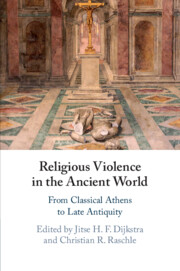Book contents
- Religious Violence in the Ancient World
- Religious Violence in the Ancient World
- Copyright page
- Contents
- Acknowledgements
- List of Contributors
- A Note on Abbreviations
- General Introduction
- Part I Methodology
- Part II Religious Violence in the Graeco-Roman World
- Part III Religious Violence in Late Antiquity
- Chapter 10 Religious Violence in Late Antiquity: Current Approaches, Trends and Issues
- Chapter 11 Coercion in Late Antiquity: A Brief Intellectual History
- Chapter 12 Crowd Behaviour and the Destruction of the Serapeum at Alexandria in 391/392 ce
- Chapter 13 Violence and Monks: From a Mystical Concept to an Intolerant Practice (Fourth to Fifth Century)
- Chapter 14 The Discipline of Domination: Asceticism, Violence and Monastic Curses in Theodoret’s Historia Religiosa
- Chapter 15 Suffering Saints: Shaping Narratives of Violence after Chalcedon
- Chapter 16 Fighting for Chalcedon: Vitalian’s Rebellion against Anastasius
- Chapter 17 The Emperor, the People and Urban Violence in the Fifth and Sixth Centuries
- Index of Sources
- General Index
Chapter 10 - Religious Violence in Late Antiquity: Current Approaches, Trends and Issues
from Part III - Religious Violence in Late Antiquity
Published online by Cambridge University Press: 18 September 2020
- Religious Violence in the Ancient World
- Religious Violence in the Ancient World
- Copyright page
- Contents
- Acknowledgements
- List of Contributors
- A Note on Abbreviations
- General Introduction
- Part I Methodology
- Part II Religious Violence in the Graeco-Roman World
- Part III Religious Violence in Late Antiquity
- Chapter 10 Religious Violence in Late Antiquity: Current Approaches, Trends and Issues
- Chapter 11 Coercion in Late Antiquity: A Brief Intellectual History
- Chapter 12 Crowd Behaviour and the Destruction of the Serapeum at Alexandria in 391/392 ce
- Chapter 13 Violence and Monks: From a Mystical Concept to an Intolerant Practice (Fourth to Fifth Century)
- Chapter 14 The Discipline of Domination: Asceticism, Violence and Monastic Curses in Theodoret’s Historia Religiosa
- Chapter 15 Suffering Saints: Shaping Narratives of Violence after Chalcedon
- Chapter 16 Fighting for Chalcedon: Vitalian’s Rebellion against Anastasius
- Chapter 17 The Emperor, the People and Urban Violence in the Fifth and Sixth Centuries
- Index of Sources
- General Index
Summary
Late Antiquity, it has long been assumed, is the historical period in which we first observe the widespread rise of religious intolerance.1 Hand in hand with this view goes the premise that there is a direct causal relationship between religious intolerance and religious violence. That is, intolerance leads to conflict; conflict leads to violence.2 Late Antiquity, in which Constantine’s conversion to Christianity is viewed as a watershed moment,3 is thus the period to which scholars look to observe religious violence and its origins.4 In the past decade and a half there has been a move to unpack these entrenched ideas, with a growing number of scholars concluding that these assumed relationships – between the rise of Christianity and religious intolerance, and between religious intolerance and religious violence – are neither inevitable nor simple.
- Type
- Chapter
- Information
- Religious Violence in the Ancient WorldFrom Classical Athens to Late Antiquity, pp. 251 - 265Publisher: Cambridge University PressPrint publication year: 2020

